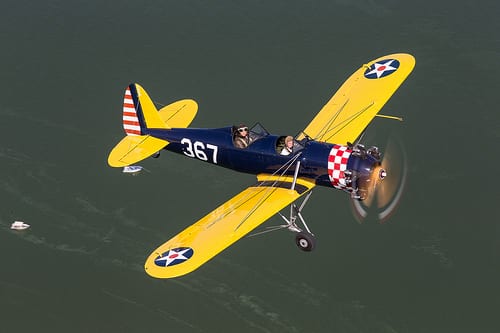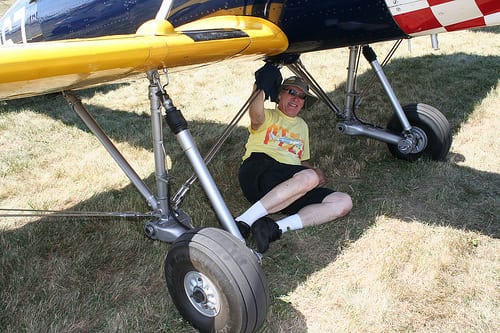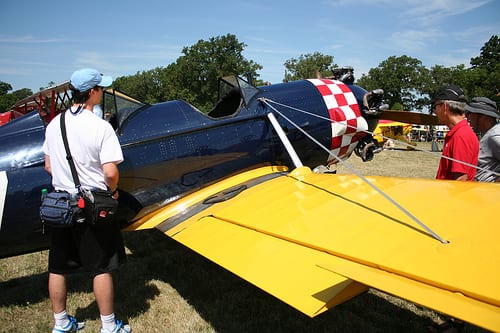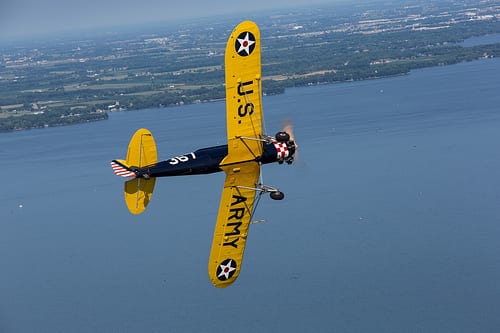There are certain traditions at airshows. For example, AirVenture is not complete for me until I see Ron Johnson’s 1941 PT-22.
Although it’s technically a Warbird, Johnson, who hails from Rockford, Ill., parks in the Vintage Area — and places toy rubber snakes on the wings of his airplane. According to Johnson, the snakes are an international way of saying DON’T TREAD ON ME. That’s important when you have a low-wing open cockpit airplane, he says, noting that some people aren’t respectful of the “Please don’t touch” placards issued by the Experimental Aircraft Association at the Oshkosh show.
 Most people are accustomed to seeing fake snakes used to keep birds from roosting on aircraft, but they also work for humans, Johnson notes.
Most people are accustomed to seeing fake snakes used to keep birds from roosting on aircraft, but they also work for humans, Johnson notes.
He has been coming to AirVenture since the event was held in Rockford, Illinois. He became interested in the PT-22 in 1976 when one of the World War II-era trainers taxied past him.
“I wanted to know what kind of airplane it was, and I knew I wanted one,” Johnson says.
He bought his plane in Kenosha. “It was tired, but a good airplane,” he says, noting it needed fabric and an engine overhaul and paint. It took two years to restore.

The PT-22 — PT stands for “Primary Trainer” — was built by the Ryan Aircraft Co. in the late 1930s. According to Johnson, it is a militarization of the Ryan STA aircraft.
“The PT-16 and PT-20 were similar, but with the narrow landing gear and the lighter weight they didn’t challenge the students enough, so Ryan added about 280 pounds and added this big wide landing gear and shock struts,” he explained. “They also swept the wings back and put a big five-cylinder Kinner engine on it. Some people says, ‘You killed this beautiful Ryan STA! But what they actually did was make a military trainer out of it.”
Johnson’s airplane is done up in military colors, but he’s not sure if the paint scheme is authentic.
“I knew I didn’t want to polish it, so I shot it with dark blue and put the US Army insignia under the wings and threw the checkerboard on the tail because I thought it made it look fast,” he says.
Johnson also added the number 367 on the tail.

“I truly don’t know what the number was for this airplane,” Johnson says with a shake of his head, adding, “because I had no panels that came off with numbers on them. I was told that the military would use the last three digits of the military assigned numbers as the field numbers, and this one is 41-15367 so I used 367.”
The engine is a R-55 Kinner. “It is 540 cubic inches that makes 160-hp on a good day,” says Johnson. “It’s kind of a boat anchor and downright bullet-proof compared to the Monasco engines that were used in the early Ryan trainers.”
Johnson notes that the Kinner engines are not without their quirks.
“The Kinner has a master rod-related issue,” he says. “It would crack at 500 hours, so at 500 hours there is a mandatory overhaul. This is not an airplane that you want to lose an engine in because it drops like a stone. It you try to stretch the glide, it will likely end up on its back.”
Johnson, who estimates he has 1,170 hours in the PT-22, notes with pride that he hasn’t missed AirVenture in 34 years. At the big show, Johnson’s airplane is a people magnet, especially attracting men of a certain age who began their flying careers in the PT during World War II.
“According to the guys who flew them, they were superb military trainers because they have a high stall speed and nasty stall characteristics,” he says. “You get this thing under 65 mph and aggravate it and you’ll be on your back. This characteristic made some people ask, ‘why would you make a trainer that way’? and the guys who flew them said it gave them an edge when they got to the BT-13, also known as the Vultee Vibrator, because they were used to an airplane that didn’t have a lot of power and nasty stall characteristics. There’s not a lot of envelope between cruise and stall speed so it made an excellent military trainer.”
But not such a great machine for civilian pilots in the 1970s, he adds.
“When I bought the airplane all I had was a private pilot license, which I earned in 1963 in an Aeronca Champ. Getting into the PT-22 was certainly a challenge,” he recalls. “It’s not a forgiving airplane, but after 10 hours I was signed off in the summer of 1979.”
Look for Johnson, his airplane, and the faux snakes in Vintage parking at next year’s AirVenture.

The incredible ignorance of some air-show attendees and their lack of respect, or at least, good judgment on how to look at an airplane and not touch it, is why I rarely take my Ryan PT-22 to airshows anymore.. I’ve heard horror stories from other Ryan owners as well that had me standing in disbelief. A few ignorant people can ruin it for all.
The problem is that in this world you can now survive being an idiot. But you cannot survive (very long) in aviation being an idiot.
Many years ago, I had my plane parked at a fly-in area. I had left the door open so that the hot sun wouldn’t cook the interior. While walking back to the plane, I could see the elevator being moved up and down, and could hear a banging noise. I discovered a young kid about 7 years old slamming the controls around from stop to stop while Dad simply stood watching with a smile on his face. I suppose that he thought my plane was open to display and a toy for his brat of a kid to abuse. I grabbed the controls and told Dad to get his son out of my plane. You would thought that I had insulted him? It just goes to demonstrate that some of the general non-flying public are idiots.